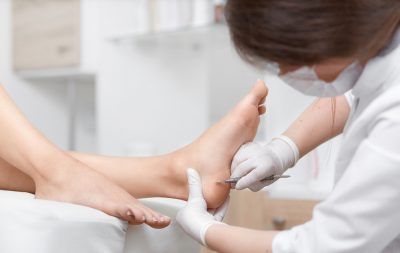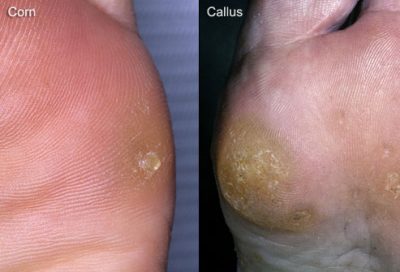
Corns and callus are probably the most common complaint for practitioners to deal with. Corns and Callus come under the category of hard skin. The difference between the two is that callus, is the flat build up of skin, and a corn is circular and deep, and ranges in size between 1-2mm to 5-7mm in general.
WHAT’S DIFFERENCE BETWEEN CORN AND CALLUS?
Callus (or callosity) is an extended area of thickened, hard skin on the feet. It is often a sign of an underlying problem such as a bony deformity, a particular style of walking or inappropriate footwear. It can also form due to scar tissue.
A corn is a funnel of ‘hard’ or ‘soft’ skin which tends to be due to pressure over a bony prominence. It can occur on top of toes/toe joints or on the sole of the foot or even between toes.
WHAT DO CORNS AND CALLUSES LOOK LIKE?

Image source: WebMD
WHERE IS THE MOST COMMON PLACE TO GET CORNS AND CALLUS?
Probably the ball of the foot is the most accepted place to experience build up of hard skin, followed by the tops of the joints of the toes (eg. hammer toes) and on the end of the toes (the apex).
Occasionally we may see corns and callus in between each toe.
ARE CORNS AND CALLUS VERY PAINFUL?
In many cases, they present little pain, however if the corn for example is on or next to a bony prominence, or under the ball of the foot, it can be very painful if left untreated.
HOW ARE CORNS AND CALLUS TREATED?
The most common practice for treating corns and callus is for the hard skin to be smoothed down by a Chiropodist by the safe use of a scalpel. The practitioner is so well skilled at the technique that they nearly never damage the skin during a treatment.
So it is generally pain free which is good news for both practitioner and patient alike.
A corn and callus will usually arise from pressure and friction.
By removing the forces from shoes by using digital splints to take pressure off the toes or by the use of arch supports, it is possible to prevent the condition entirely.
It is important to note that many cases are unique and a discussion of the condition with the Chiropodist is highly recommended.
HOW TO PREVENT CORNS AND CALLUSES?
One of the ways you can avoid corns and calluses is to ensure that your shoes fit properly, that they are not tight around the toes, that your shoes are the correct size (just as the rest of the body can change shape and size as you go through life, so can your feet) and sometimes you will find that you need a different shoe size than when you were 21.
Sometimes, calluses can be caused due to the way your foot works as you walk and this might be helped by seeing a Podiatrist/Chiropodist who may suggest a pair of insoles.
